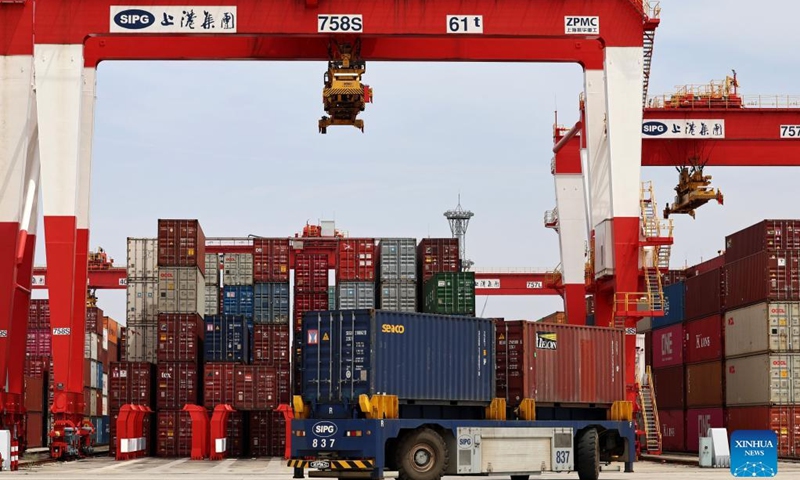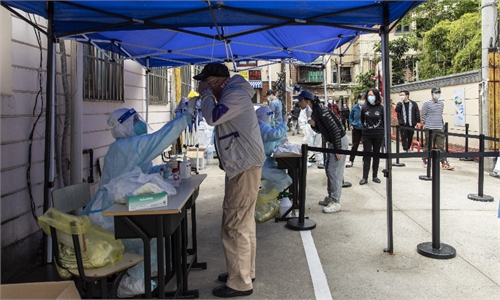Shanghai port reports 8.14% jump in Q1 throughput, but virus impact looms large in April

A truck carrying containers is seen at the container dock of Shanghai's Yangshan Port in east China, April 27, 2022. About 25,000 staff members stick to their posts in Shanghai port to guarantee water transportation and improve logistics efficiency amid challenges caused by the recent resurgence of COVID-19 in Shanghai.(Photo: Xinhua)
The Port of Shanghai, one of the world's largest ports in terms of cargo tonnage, reported a stable increase in turnover during the first quarter of 2022, but the port has seen significant disruptions since the end of March, when a severe wave of COVID-19 started in the major Chinese financial and trade hub, according to official data on Thursday.
The turnover of Shanghai port picked up by 8.14 percent in the first quarter from a year earlier to 12.26 million twenty-foot equivalent units (TEUs). But in April, the average daily container throughput is expected to be equivalent to 100,000 TEUs, about 75 percent of the previous levels, data from the Shanghai Municipal Transportation Commission showed.
Still, "the Shanghai port has never stopped operating for a day since public health measures were put in place," said Tu Weifeng, an official from the commission, adding that the overall operation efficiency at Shanghai port has not been affected by anti-epidemic efforts in the city.
Analysts said that the capacity of the port has mainly been hurt by the congestion on roads rather than the port itself. The Shanghai International Port Group (SIPG) also said earlier this month that efficiency at the Shanghai Port has been affected to a certain extent due to the lack of truck drivers.
Zhong Zhechao, founder of One Shipping, an international logistics service consulting company, told the Global Times that congestion at the Shanghai port is very serious and nearly 60 percent of the cargo at sea and air terminals were stuck.
Given the seriousness of the issues, Chinese officials and companies have taken various measures to tackle the logistics problems, including issuing nationally unified vehicle passes and reopening highway toll stations and services centers to ensure smooth transportation.
As a result, transportation of containers at the port has been recovering steadily, with shipments entering and leaving the port recovering to more than 20,000 TEUs per day from less than 10,000 at the height of the epidemic, according to the port.
With more targeted efforts and supportive measures in place, experts expect that the situation could improve from May as Shanghai's battle against COVID-19 enters a key phase.
In an optimistic scenario, the impact on the port and supply chain could be eased in the second quarter, boosted by rising shipment demand and an accelerated return to normal operations starting from May, Wu Minghua, an independent shipping industry analyst in Shanghai, told the Global Times on Thursday. "The improvement in May could cover for some of the losses in April," Wu said.
Resumption of work in Shanghai is also gaining pace after more districts in Shanghai declared achieving the goal of COVID clearance in communities.



